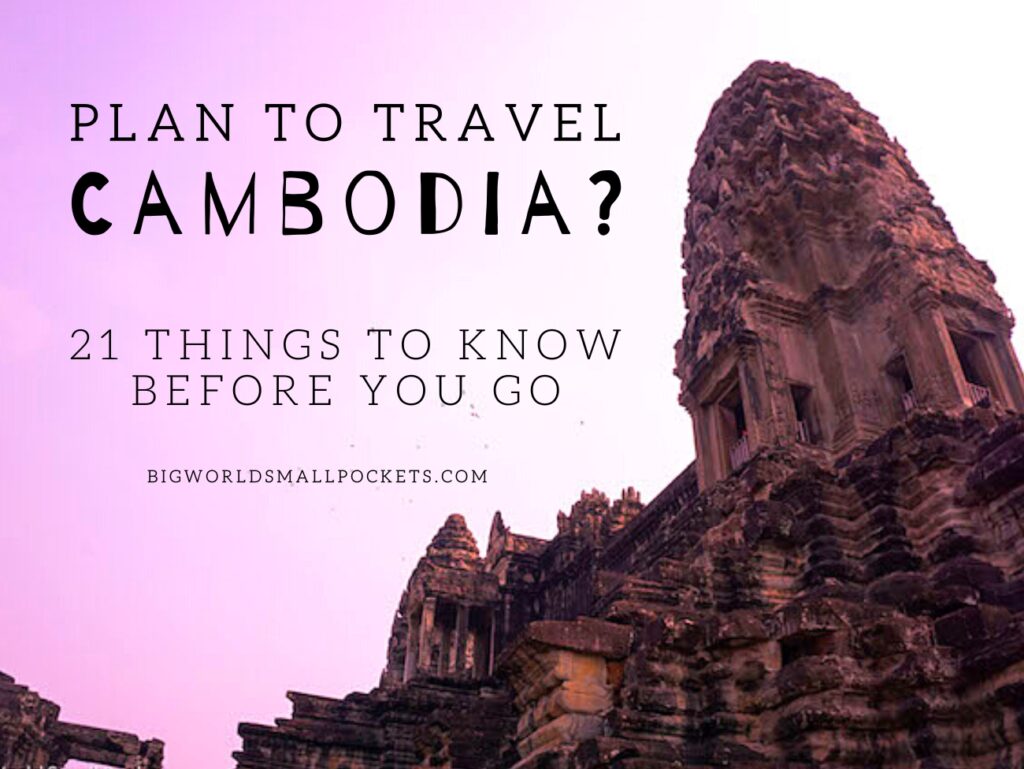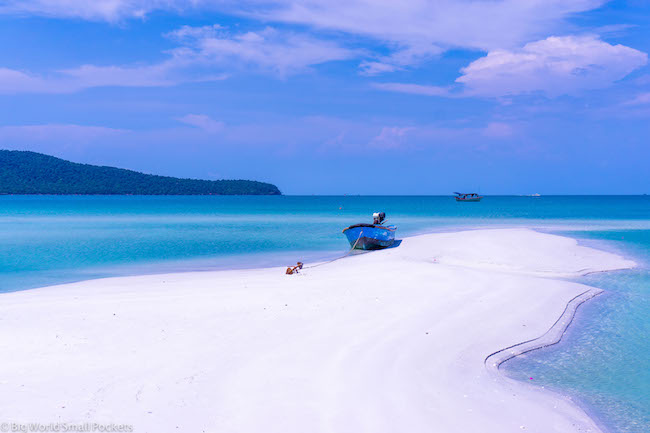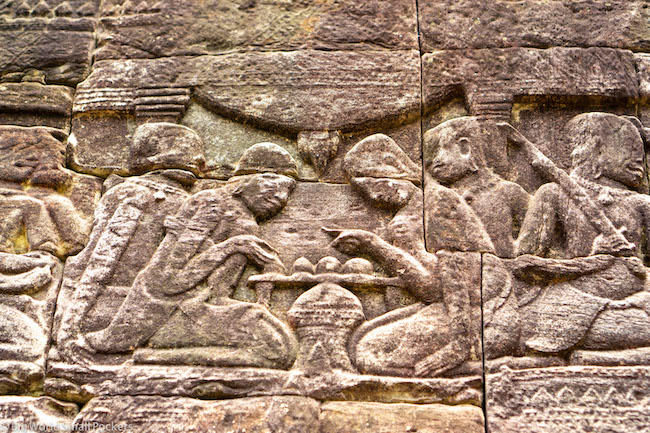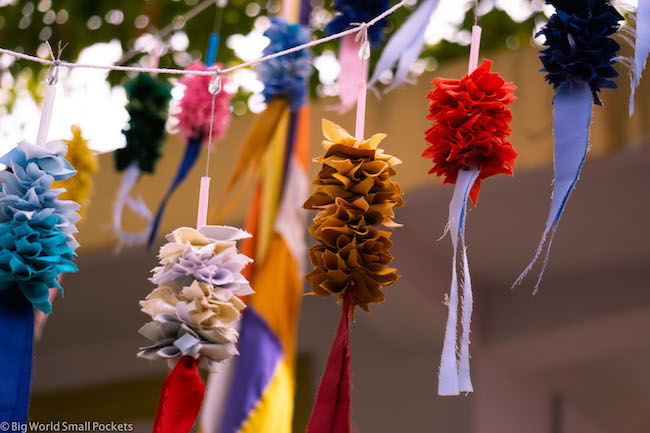The little gem of Cambodia is a travel paradise! And here’s everything you need to know before you visit!
Offering a slower pace of life than you’ll experience in neighbours Vietnam and Thailand, those who travel Cambodia often find it a welcome and relaxing break between these more hectic and fast-paced destinations.
But while Cambodia might be laidback, don’t let that fool you into thinking this country is a bit dull. Filled with vibrant night markets, beautiful tropical islands, lush jungle and ancient temples galore, adventuring here is easy, cheap and incredibly enjoyable.
No surprise therefore that I highly recommend including this country on your bucket list and, to help you out, here’s the 21 things you need to know before you travel Cambodia…
Related Posts
- Perfect Southeast Asia Packing List
- Perfect 2 Week Cambodia Itinerary
- Ultimate Vietnam and Cambodia Itinerary
This page contains affiliate links meaning Big World Small Pockets may receive a small commission on any purchases at no extra cost to you.
#1 What is the Climate Like?
Situated in Southeast Asia, Cambodia boasts a tropical climate – meaning it’s hot most of the year!
Within this, Cambodia has 3 main seasons:
March and April: Known as summer, this is the time before the rains come. Expect dry, dusty and very sweaty conditions at this time!
May to October: Following summer, this is when the rains come to Cambodia, cooling things down but also bringing storms and occasional flooding. The countryside however gets much greener as a result!
November to February: Known as winter, the dry and cooler (although still pretty hot) season is when most visitors choose to travel Cambodia.
#2 When to Travel Cambodia?
Choosing when to travel Cambodia largely depends on your priorities.
There’s no question the best weather is during the dry and cooler winter months from November to February, but this is when most tourists visit, so expect higher prices and bigger crowds at this time.
Transport around the country and accommodation should be booked in advance at this time of year.
The shoulder season during the dry and very hot months of March and April is a good time to travel Cambodia if you deal ok with humidity and high temperatures.
This is when I went and I loved it, although I do have a broken internal thermostat so…!
With crowds thinning out in March and April, prices are lower and you’re less likely to have to book much stuff in advance.
The biggest holiday season of the year for locals – Cambodia New Year – falls during these months however, so do consider this when planning your itinerary as travel during this public holiday can be difficult.
Finally, the wet season between May and October definitely sees the tourist numbers thinning across Cambodia, as daily, heavy rain showers can put a dampener on planned activities and island time.
#3 How Long to Visit Cambodia For?
While not a huge country, Cambodia offers those wishing to travel within her borders a lot of diverse stuff to see and do.
As a rough guide, 2 weeks is the minimum amount of time I think you should allow to see most of the major sights here.
3 weeks will give you time to cover everything and to enjoy travelling Cambodia at a slightly slower pace.
4 weeks – the length of most Cambodian tourist visas – will allow you to travel here at a very leisurely pace, journeying across large swaths of the country and spending a good amount of time on the islands where basically everyone extends their stay!
Just enter your details below and I'll email it you - simple!
Information will be sent to the email provided above
#4 Best Places to Visit in Cambodia
One of the most important things to know when planning your trip to Cambodia is where to go in this country.
To help you out, here’s a list of my favourite spots – the ones you really should not miss.
Siem Reap & Angkor Wat: You can’t come to Cambodia and miss its most famous attraction! UNESCO-listed Angkor Wat is a must during your time here and the nearest access point to this temple treasure is the city of Siem Reap, where you should plan to stay for at least a few days. Don’t forget to get up super early on at least one day to catch an amazing Angkor Wat sunrise and learn how to buy tickets for this incredible place (as well as which tickets to buy) in this article I wrote.
Battambang: A cute city with a relaxed pace and some delightful colonial architecture, Battambang is most famous for its Old Bamboo Train and impressive bat display – which is more impressive than it sounds, trust me! Most travellers spend a night or 2 in this small town.
Phnom Penh: Cambodia’s capital, Phnom Penh offers visitors a riverside setting with Mekong views and important sites that chart the shocking history of Cambodia’s recent genocide including the Killing Fields and S21 Prison. 2-3 nights in Phnom Penh is a good amount of time for most travellers.
Kampot & Kep: 2 destinations very near each other, Kampot is a relaxed, country town with some good cafes and interesting day trips, while coastal Kep offers some sea air and island stays. Many travellers stay in 1 location and day trip to the other.
Koh Rong Sanloem: Sanloem is the smallest of the 2 Koh Rong islands in the south of the country and a mecca for those who backpack Cambodia. Prepared to get stuck for much longer than you planned here thanks to the chilled vibes and rustic feel of this drop of paradise. Check out my ultimate guide to Koh Rong Sanloem, which includes info on how to get there, where to stay and what to do.
Get more info about all these spots and more in my list of the top 10 things to do in Cambodia!
#5 How to Travel to Cambodia?
International airports can be found in both the cities of Siem Reap, Sihanoukville and Phnom Penh, meaning easy connections can be made from other countries in Southeast Asia as well as further afield.
As always, I use Skyscanner to find the best ticket prices on flights.
Cambodia has land borders with Thailand, Vietnam and Laos, all of which can be easily crossed care of straightforward bus connections.
For more information about crossing from Bangkok to Siem Reap, check out my post about this journey here.
For more information about crossing from Kampot to Ho Chi Minh, take a look at my article that explains how I did it here.
For all land border crossings, as well as bus journeys within Cambodia itself, check 12Go, which is a great transport booking website offering schedules, prices and the ability to book buses online. in advance and securely.
When it comes to actual bus companies, I highly recommend Giant Ibis in Cambodia, who offer comfortable long-distance bus services, including helping you navigate immigration at border crossings too – couldn’t be easier!
#6 Cambodia Travel Visas
Before you cross any borders however, do check your eligibility for a Cambodian visa.
As a British citizen, I was entitled to a 30 day tourist visa, which I could be granted on entry at some land borders and at all international airports.
If you plan to arrive in Cambodia overland, check if the border post of your intended crossing offers visas on arrival.
If they don’t, I suggest you get a Cambodia Visa online in advance, which you can do very simply via the official government website. Check this site for details of whether you are eligible.
If you are, you will pay a small admin fee to get your visa online, but you may be forced to pay “a handling fee” at any land border anyway, and some overland crossings require you to have a visa in advance, so I vote it as a good option regardless.
In all honesty, I advise getting an eVisa regardless of whether you are travelling to Cambodia by land or air, it makes immigration so much simpler and will also save you a full page sticker if you’re short on pages in your passport as I was!
#7 How Much Does it Cost to Travel Cambodia?
While Cambodia, like most of Southeast Asia is “cheap” to travel, it’s not as affordable as it once as and you may be surprised to discover how much you do spend while there.
Indeed, many travellers I met on the road in this country were shocked by how much they spent in Cambodia, citing it was “not as cheap as they expected.”
Generally speaking, a budget of £40 / 40€ / $45 USD should be allocated as a minimum per day.
This will include a mix of dorm rooms and private rooms during your stay, all bus / boat travel, a mix of restaurant and street food meals, drinks and day trips / excursions including the hefty entrance fee to Angkor Wat.
You can spend less if you are travelling on an absolute shoestring and you can definitely spend more!
Get more info on what it costs to travel Cambodia, including exactly how much I spent during my 2 weeks in the country, here.
#8 USD or Riels?
Cambodia uses a dual currency system, meaning local Cambodian Riels (KHR) and US Dollars (USD) are used interchangeably throughout the country.
Many tourist prices for accommodation, long-distance buses and day trips are quoted in USD.
At the time of publication, $1 equated to 4000 KHR, which comes in denominations of 100, 500, 1000, 2000, 5000, 10000, 20000 and 50000 notes, as well as the almost worthless 50, 100, 200 and 500 Riel coins!
#9 Using ATM Machines
ATMs are plentiful across Cambodia and accept both Visa and Mastercard without issues.
ATM machines here allow you to withdraw both USD and KHR, which is very handy – see the point above!
And when it comes to paying for things in Cambodia, or using ATMs, you want to ensure you’re not being charged overseas transaction fees or getting poor exchange rates when using your card abroad, which is why I always take my Wise card away with me wherever I travel.
The easy way to spend abroad with real exchange rates, no markups and no sneaky transaction fees, you can use your Wise card just like a debit card here… and it links easily with Google and Apple pay – sold! Grab yours here.
#10 How to Travel Around Cambodia?
Buses around Cambodia are plentiful and easy to use, making them the best way to travel when you travel Cambodia.
Often, between tourist destinations, buses are laid on exclusively for travellers and these generally pick you up and drop you off at your accommodation making them very straightforward to get.
For long-distance buses in the country, such as between Phnom Penh and Sihanoukville, I recommend using luxury buses instead of minivans.
Giant Ibis and Champa Mekong are both good companies to look out for.
You can book tickets with these 2 companies, as well as many other buses around Cambodia online at 12Go.
I recommend booking buses a day before your date of travel as tickets do sell out, especially in high season.
#11 Getting Around Cambodian Cities
For transport in and around cities in Cambodia, scooters can be hired from most hostels, as well as rental companies on the street.
Otherwise, tuk-tuk and taxis are common in this country too.
Using the ridesharing apps Grab or PassApp will help ensure you don’t get ripped off and can assist you in navigating language barriers as well.
Alternatively, Bookaway is a great travel website that compares buses and flights across Cambodia. Check it out .
#12 Best Hostels in Cambodia
And now we’ve come to where to stay when you travel Cambodia.
Hostels are plentiful and easy to research, as you can read reviews as well as book them online.
Here’s my pick of the bunch – all personally tried and tested!
Siem Reap: Onederz Hostel
Battambang: Pomme
Phnom Penh: Feliz Hostel
Kampot: Ganesha Eco Lodge
Sihanoukville: Onederz Hostel
Koh Rong Sanloem: Hornbill Guesthouse
#13 Internet Access in Cambodia
And you’ll be delighted to know that all the above hostels, as well as every other hostel I stayed in during my time in Cambodia, had free wifi.
In fact, free wifi in Cambodia is everywhere including cafes and even buses – I love you SE Asia!
You can also easily pick up a tourist SIM card in Cambodia.
I got mine with Unitel and paid $15 USD for a 2 week SIM with 15GB of high-speed data + unlimited low-speed data and free calls.
You can pick up a SIM at any airport or at the many vendors on the street.
Don’t make sure your smartphone is unlocked before you travel to Cambodia.
#14 Conscious Travel in Cambodia
One of the things I loved most about travelling Cambodia was the number of conscious travel solutions there were.
From eco-tours and cafes supporting local women groups, to shops selling fairly-traded souvenirs and natural beauty products, it’s great to know that when visit Cambodia you can spend your money wisely in ways that help local people.
#15 Khmer Language
Khmer is the name of the local language in Cambodia and it also has its own alphabet, which renders it largely indistinguishable for European foreigners!
Thankfully, almost everyone who works in the tourism industry in Cambodia speaks English and, certainly at your accommodation, fluent English speakers will be on hand to help you where needed.
#16 Cambodian History
If you weren’t aware, Cambodia has suffered what can only be described as a truly horrific genocide.
Take the time to learn about this country’s tragic recent story at the Killing Fields and S21 Prison in Phnom Penh.
At Angkor Wat, you’ll then have a chance to balance the books and learn about Cambodia’s historic glory days when the empire based here ruled huge swathes of this part of the world.
#17 Day Tours in Cambodia
And a great way to learn about this history and visit lots of the amazing attractions in Cambodia is to enjoy a number of day trips.
These can easily be arranged online, in advance.
If you plan to backpack Cambodia on a tight timeframe, then I highly recommend TakeMeTour, who I used for several trips in the country, including a day cycling day around Angkor Wat that was fantastic.
#18 Food & Drink
Tap water in Cambodia is not drinkable.
Bottled water is easily and cheaply available, but help the environment by bringing a filter water bottle with you to save the plastic bottle waste.
You can also help the environment by bringing a metal reusable straw with you to Cambodia so can enjoy all of the delicious fruit juices here without adding to the amount of plastic waste.
Food is Cambodia is cheap, especially on the street, and is similar to Thai food.. ish.
Vegetarians may struggle because everything is cooked in fish oil – you have been warned!
That said, fried rice with veg is plentiful… of course!
#19 Footwear in Cambodia
Sandals are going to be your best friend in Cambodia – not only because of the heat, but because you have to remove footwear when you go into basically any building in this country, including hostels.
This is common across Southeast Asia, so do yourself a favour and bring some sandals, like Birkenstocks, that you can easily slip on and off.
Learn more about what to pack for your Cambodia trip here.
#20 Solo Female Travel & General Safety
I backpacked Cambodia as a solo female, as well as met many others doing the same when I was there, and can definitely attest to the fact that travelling alone as a woman is both safe and easy here.
You’ll meet lots of people, receive little to no male harassment and will feel safe walking around by yourself, even at night, in most well-lit tourist destinations.
World Nomads offers simple and flexible travel insurance. Buy at home or while travelling and claim online from anywhere in the world.
Alternatively, if you’re a long-term traveller, digital nomad or frequent remote worker seeking travel health cover, check out Safetywing’s Nomad Insurance policies.
#21 Crime Risks When You Travel Cambodia

And on this note, it’s worth pointing out that crime against tourists in Cambodia is low and overall I’d rank it as an incredibly safe country to travel.
The main things to watch out for are being ripped off, classic travel scams and pickpocketing on the street – bag snatching in Phenom Penh is particularly prevalent, so do watch your phones etc when you’re walking in this city, especially when it comes to passing mopeds.
The biggest danger (to the world) in Cambodia is the litter / trash situation, which is disheartening to say the least.
SAVE IT IT TO PINTEREST!
And so there you have it, the 21 things you need to know before you travel Cambodia.
Have you travelled to this Southeast Asian gem?
Do you have any advice to add to the above?
If so, please help other travellers out, by leaving your thoughts in the comments below…
























It’s a very cool article, thanks for a lot of information. I wished I stumbled upon your post before going to Cambodia as it will help a lot to save some money. We did a trip around Cambodia by motorbike for a month. It was one of the most beautiful countries I’ve traveled too and will definitely come back. If you’re traveling with motorbike, be sure to invest a bit more in a bike since the roads aren’t the best. Cheers. 🙂
Great tip Antonio, sounds like an epic adventure you enjoyed in Cambodia 🙂